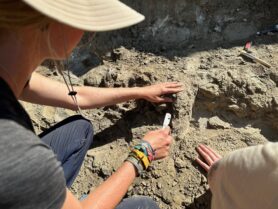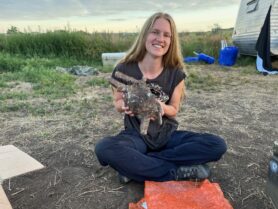Recente toekenningen
Daan van den Elzen volgt een dubbele master diergeneeskunde en aardwetenschappen aan de Universiteit Utrecht.
“Mijn masterthesis focust op pathologische botten van Triceratops uit de collectie van Naturalis Biodivercity Center en het Eastern Wyoming Nature Center. In samenwerking met de faculteit diergeneeskunde en geowetenschappen van de Universiteit Utrecht en Naturalis ga ik CT-scans (computertomografie) maken van de individuele botten om te onderzoeken of deze pathologisch zijn en om te achterhalen welk ziekteproces heeft plaatsgevonden. Daarnaast wordt van enkele botten naar de histologie gekeken met behulp van slijpplaat-microscopie. Ook zal ik twee vergroeide Triceratops-ruggenwervels onderzoeken.

Afgelopen zomer heb ik de mogelijkheid gekregen om naar Wyoming, Verenigde Staten te reizen om deze wervels te kunnen bekijken, de vindplaats te bezoeken en mij aan te sluiten bij het opgravingsteam van het Wyoming Dinosaur Center. Het werk was zwaar, maar ontzettend leuk en leerzaam. Om de onkosten van mijn reis te kunnen betalen, heb ik een beurs mogen ontvangen van het Hans de Bruijn fonds, waar ik ontzettend dankbaar voor ben. Voor mij is dit een droom die uitkomt en ik ben enorm blij dat er fondsen zijn die dit mogelijk maken voor mij en andere toekomstige paleontologen.”
Mathieu Boisville doet een PhD-project aan de University of Tsukuba, Japan. In september 2023 bezocht hij met steun van het Hans de Bruijn-fonds de fossielewalruscollecties in Nederland.
“The overall aim of my visit to the Netherlands was to increase my database with the large number of extant but also fossil walruses (Odobenus rosmarus), and fossil species Ontocetus emmonsi the Dutch collections have to offer. My aim is to study mandibles and skulls, and compare them with material from Japan. This visit allowed me to record landmarks and semi-landmarks, using tpsDig software, and to apply geometric morphometric analyses (e.g. Procrustes ANOVA) with R Studio, in order to compare different populations of fossil walruses, to better understand their past diversity through time and space.
I spent my first two days in the NNM collections with the aim of adding to the large number of specimens. The next day I went to Utrecht, to visit the collections of the UMU (Universiteitsmuseum Utrecht) to observe a very special specimen of Odobenus rosmarus, described by Rutten at the beginning of the 20th century. The next week I visited the Naturalis Biodiversity Center collections in Leiden, which also has a large collection of specimens of the extant Odobenus rosmarus, but also some very interesting fossil specimens of Ontocetus emmonsi, which after observations may actually belong to a quite different taxon whose manuscript I am currently preparing. Finally, I visited the collections of the Zeeuws Museum in Middelburg, where I was able to observe two well-preserved skulls; a complete skull of Odobenus rosmarus from late Pleistocene deposits and material of Ontocetus emmonsi from the early Pleistocene (Gelasian).
number of specimens. The next day I went to Utrecht, to visit the collections of the UMU (Universiteitsmuseum Utrecht) to observe a very special specimen of Odobenus rosmarus, described by Rutten at the beginning of the 20th century. The next week I visited the Naturalis Biodiversity Center collections in Leiden, which also has a large collection of specimens of the extant Odobenus rosmarus, but also some very interesting fossil specimens of Ontocetus emmonsi, which after observations may actually belong to a quite different taxon whose manuscript I am currently preparing. Finally, I visited the collections of the Zeeuws Museum in Middelburg, where I was able to observe two well-preserved skulls; a complete skull of Odobenus rosmarus from late Pleistocene deposits and material of Ontocetus emmonsi from the early Pleistocene (Gelasian).
I would like to sincerely thank you once again for providing me with this invaluable assistance, in addition to the help that my university also offers me. I will keep you informed of the progress of my PhD thesis, with regard to all these Dutch specimens.”

